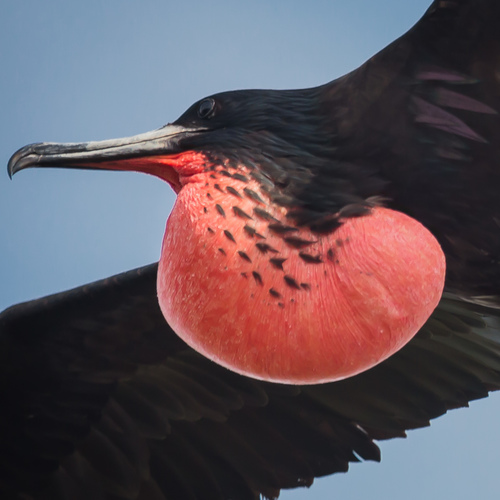
Magnificent Frigatebird
The Magnificent Frigatebird (*Fregata magnificens*) is a large seabird renowned for its impressive aerial displays and distinctive appearance. It plays a crucial role in marine ecosystems as a top predator, often indicating the presence of fish schools. Culturally, it has been a symbol of seafaring and navigation for various coastal communities, and its image appears in some traditional art and folklore. This species is unique for its extreme sexual dimorphism and kleptoparasitic behavior, where it steals food from other birds.
89-114 cm
Length
217-244 cm
Wingspan
Least Concern
Conservation Status
Distribution
Tropical and subtropical regions of the Atlantic and Pacific Oceans. Breeds along coastlines and islands from the Caribbean and Cape Verde Islands to the Galapagos Islands and Baja California. Non-breeding birds can range more widely.
Lifespan
Up to 30 years in the wild, potentially longer.
Magnificent Frigatebird's Habitat
Habitat Types
Coastal areas, Offshore islands, Mangrove forests, Open ocean (for foraging)
Climate Zones
Tropical, Subtropical
Adaptations
Highly efficient soaring flight capabilities allow them to remain aloft for extended periods, covering vast distances over the ocean. Their lightweight skeleton and large wingspan are key adaptations for this.
Variations
While generally considered monotypic (no recognized subspecies), some regional variations in size and plumage have been noted, but these are not formally classified.
Appearance
Breeding Plumage
Adult males are all black with a distinctive inflatable gular sac (throat pouch) that turns bright red during breeding season. Females have a white breast and belly. Juveniles have a white head and underparts.
Seasonal Feather Changes
The most significant seasonal variation is the inflation and coloration of the male's gular sac during breeding.
Sex Based Plumage Differences
Pronounced sexual dimorphism; males and females have significantly different plumage.
Notable Features
Inflatable gular sac (males), Deeply forked tail, Long, hooked bill, Small, weak feet (not adapted for walking or swimming)
Diet and Feeding
Primary Foods
Flying fish, Squid, Small fish, Jellyfish, Crustaceans
Foraging Behavior
Primarily catches prey from the ocean surface while in flight. Also known for kleptoparasitism, harassing other seabirds (like boobies and terns) to force them to regurgitate their catch.
Specializations
Exceptional aerial agility and speed allow them to snatch prey from the air or water surface without landing. Their hooked bill is well-suited for capturing slippery prey.
Seasonal Diet Variations
Diet may shift slightly depending on the availability of prey, which can vary with ocean currents and seasonal migrations of fish and squid.
Behavior
Social Structure
Highly social, often nesting in large colonies and foraging in groups. Outside of breeding season, they may form large roosts.
Communication
Vocalizations (rattling, croaking, and whistling sounds), Visual displays (gular sac inflation, wing movements), Bill-clattering
Migration
While not undertaking long, regular migrations like some seabirds, they can disperse widely after breeding, following food sources. Some populations are more sedentary.
Territorial or Group Behaviors
Males defend small nesting territories within the colony. They are highly social when foraging and roosting.
Conservation
Threats
Habitat destruction (loss of nesting sites), Overfishing (reducing prey availability), Plastic pollution (ingestion and entanglement), Climate change (affecting ocean productivity and prey distribution), Human disturbance (at breeding colonies)
Protection Programs
Protection of nesting sites, International agreements on fisheries management, Marine protected areas
Local National Laws
Protected under various national laws in countries within its range, such as the Migratory Bird Treaty Act in the United States.
Population Trend
Stable
Population Estimates
Global population estimated to be in the hundreds of thousands, but precise figures are difficult to obtain.
Interesting Facts
They have the highest ratio of wingspan to body weight of any bird.
This allows for incredibly efficient soaring and gliding flight.
They cannot easily take off from water.
Their small feet and long wings make it difficult to gain lift from a flat surface.
They can stay aloft for days and nights without landing.
They utilize air currents and thermals to conserve energy.
They rarely swim or land on the water
Their feathers are not very waterproof, and they would become waterlogged.
Faqs about Magnificent Frigatebird
Why do male frigatebirds have a red throat pouch?
The gular sac is used in courtship displays to attract females. Males inflate it like a balloon to show off their fitness.
Can frigatebirds swim?
They are not well-adapted for swimming. Their feathers are not waterproof, and their small feet provide little propulsion in water.
How do frigatebirds get their food?
They catch fish and other prey from the ocean surface while flying, and they also steal food from other birds.
Are Magnificent Frigatebirds endangered?
No, Magnificent Frigatebirds are classified as 'Least Concern' by the IUCN. While they face some threats, their populations are currently considered stable.
Copyright @ Nature Style Limited. All Rights Reserved.
 English
English